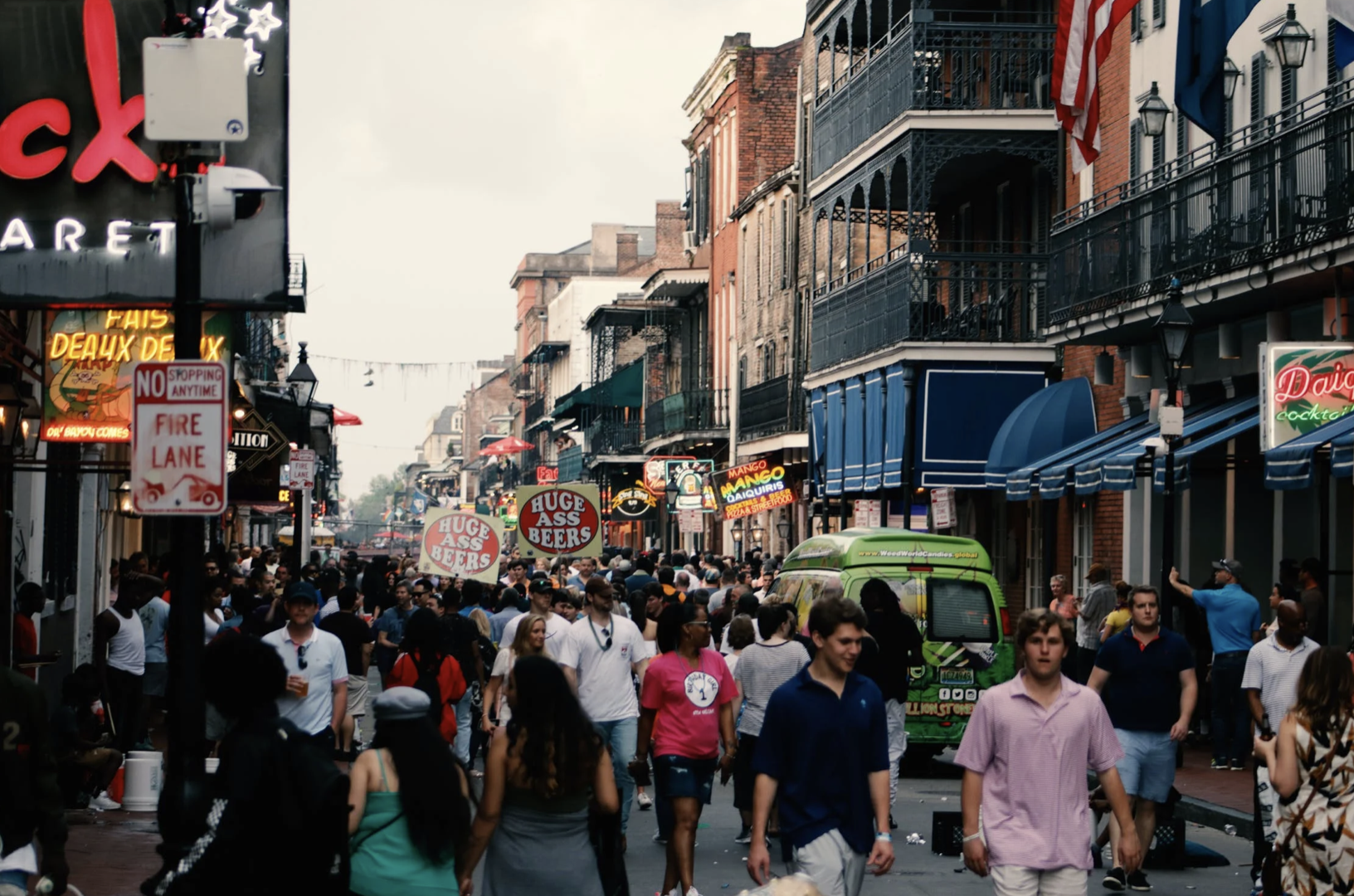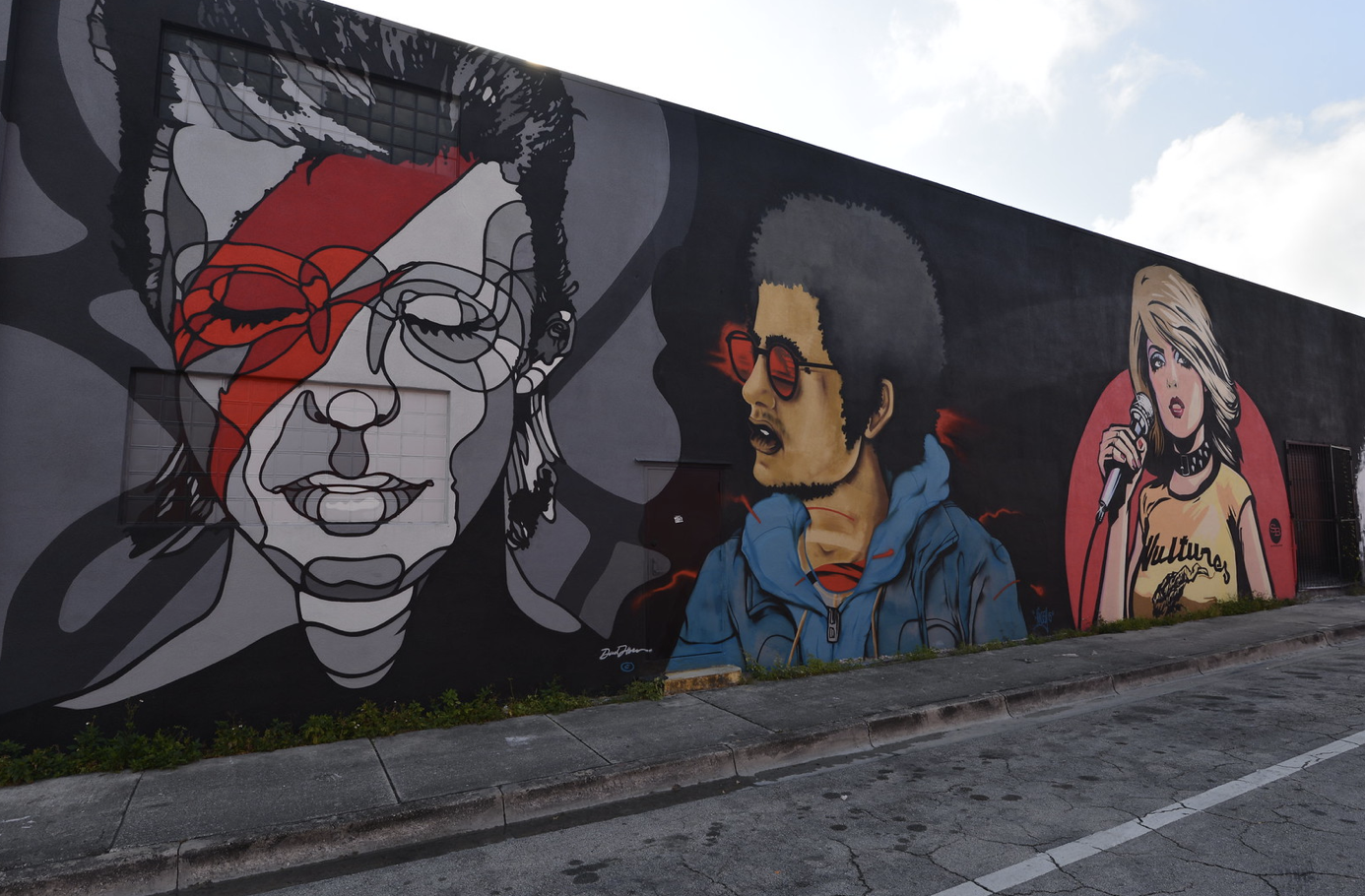Part 1: What is the problem? Why is it a problem?
A walk down Canal Street that divides the French Quarter from the Central Business District of New Orleans reminds me of a walk down Madison Avenue at the heart of Manhattan, New York, except 10x slower. New Orleans has attracted so much attention and is known for their laid-back culture. The city earned the title “The Big Easy,” and the big easy it is. If you were to ask an individual in New Orleans a pressing question, they would probably respond with one of their “lax” phrases saying “pass a good time” or “who dat?” Dare I say, New Orleans is quite careless at times. A gambling and burlesque-filled Bourbon Street, over 130 festivals per year, and pure fun are the roots of New Orleans, but has the city become too chill?

The carefree, lively Bourbon Street in New Orleans’ French Quarter (Kendall Hoopes, Pexels)
New Orleans radiates historical southern energy; it is great to remember the past, yet when many other cities in the world have jumped on the bandwagon of modern business New Orleans ends up in last place, economically speaking. The job market in New Orleans is minuscule and does not seem to be expanding, with the current unemployment rate at 6.95%, due to the lack of motivation and drive from the locals.
The grandiose amount of people without jobs is because of the unavailability of jobs. Tourism is New Orleans greatest source of income with “15,458 jobs as part of the hospitality and tourism culture in Orleans Parish.” Whereas other cities in America are expanding each and every job market, New Orleans has only had 45 technology startups since 2006, the establishment of only 27 finance firms, 21 malls that barely provide retail positions, and 138 legal firms in the city and surrounding areas.
The city is lacking in major markets that could change their economic and employment status. Other places in the United States live to work, New Orleans works to live…but barely.
The average household income in New Orleans is around $73,963 with an average cost of living equating to around $5,000 per month. According to Juanita Jackson, New Orleans has “always been a town for those seeking a good time” (Jackson 1). New Orleans residents prioritize fun and enjoyment over having a sustainable job, which in theory sounds nice but is rapidly deteriorating the city.
This issue does not simply lie on the individuals that reside in New Orleans…the city is at fault too. In his article titled “The Struggle is Real for New Orleans Graduates Looking for Jobs in Uncertain Job Market,” Kenny Lopez explains that even motivated individuals that are fresh out of college cannot stay in New Orleans because of the impossibility to land a successful job. McKenna Price-Patak explains that “it doesn’t really feel like a growing market. You’re competing for a set number of jobs.” There was a shift in certain cities’ economies in the 1800s, during the industrial revolution, from agricultural to modern business. New Orleans avoided that change centuries ago and does not seem to be acting on it now. Cities like Manhattan, that brings in around 66.6 million tourists per year, and San Francisco, bringing in around 25.8 million tourists per year, promote their own culture like New Orleans, but they also have more contemporary businesses that allow for a plethora of jobs.

Pictured is a homeless man that resembles so many New Orleans residents (MART PRODUCTION, Pexels)
The root of this issue stems from the instant an individual is born. New Orleans residents are born into the “Big Easy” mindset—work a little to have a good time for a while and as they say in New Orleans, “Laissez Les Bon Temps Rouler,” or let the good times roll. “Building Back New Orleans: Not as it Once Was, but Like it Always Should Have Been,” written by Mitchell J. Landrieu, discusses the corruption of the education system in New Orleans. Landrieu says that “New Orleans schools were considered among the worst in the country. Two-thirds of our kids were in failing schools” (Landrieu 203). His argument proves that this is a cultural issue. Not to blame the extensive poverty on the “lax” culture of New Orleans, but children are never given anything to work or aspire for. Regardless of if the educational system in New Orleans has money or not, children should still be taught that the New Orleans economy is not up to par. They should be motivated to make a difference.
We see the lack of motivation in children based on their lack of motivation in school. In 2019, 35 out of the 72 charter schools in New Orleans had the majority of their students with D’s or failing grades by the end of the school year. With the less than adequate school system and the vast majority of jobs laying in the tourism industry, the homeless rate in New Orleans is through the roof. For every 100,000 residents 302 are homeless which is truly terrifying and needs to be changed. New Orleans is hitting a low point regarding poverty, unemployment, and homelessness rates and a fix must be implemented to avoid self-destruction.
Part 2: A Solution
Throughout history, the LatinX community in South and Central America has been very agricultural based, being that their crops account for 16% of the total global food exports. South and Central American countries’ economies have always relied on what crops they grow or what natural resources they have an abundance of, which equates to 5-18 percent of their GDP.
Centuries ago, this business was efficient, and while it still is in some ways the rest of the world has entered a more modern economy—an economy that mimics that of Wall Street in Manhattan. In an effort to conserve their culture in the 1980s, many Latin American countries, the worst being Panama, Argentina, and Nicaragua, were drawn into bankruptcy. While New Orleans is not as extreme, the city’s trajectory looks similar. A country like Cuba is a well renowned tourist site and residents make a living based on their agriculture; yet, besides those two markets there are no jobs available. Jorge Salazar-Carrillo explains in his article, “Why Cubans took to the stress: 3 questions about Cuba’s economic crisis answered,” that “Cuba’s economy relies largely on tourism and raw exports such as rum, tobacco, sugar and minerals” (Salazar-Carrillo). Without this market, Cuba would have no source of income. Tourism and agriculture were not enough, and that is where Miami came in.
Miami, Florida is known to be a luxurious spot for vacation, high end shopping at Balenciaga, Cartier, and Dior, Michelin star restaurants like Forte dei Marmi, and ultimate tourism, approximating around 24.2 million visitors per year. Before Miami earned this luxe reputation, it was inhabited by a bunch of low class LatinX migrants that were looking to enter a larger job market and Miami’s “go with the flow” mantra, which was more relaxed than many other cities in the United States, opened up the city as the best place for migrants to establish themselves.

Pictured is the luxurious Miami Beach skyline at night (Elvis Vasquez, Pexels)
Miami is an American city; yet, its wealth and the root of its flourishment comes from the LatinX community that has migrated to the city throughout time. The culture is still loud and prominent in Miami; yet, the LatinX community applied their culture in a way that has been profitable and has opened up jobs for so many Hispanic individuals being that 70% of Miami’s population is Latin American.
Diversity is at the root of Miami’s flourishment; the LatinX community took their pride and made it a business. Rohit Arora, on Forbes, explains that Miami’s diverse economy is what makes it boom. For instance, the Wynwood Walls are one of the biggest tourist attractions in Miami. In 2009, a man named Tony Goldman established the Wynwood Walls as a place for artists to revamp warehouses. The Wynwood Walls are a place that urges international artists to present their work to the public and contribute to the development of the walls. The walls are filled with graffiti and street art that symbolize where each artist was born or what they believe in. This way, the Latinx and other foreign artists can still promote and preserve their cultural roots while also making a job for themselves and preventing debt and homelessness. According to their website, a General Admissions ticket is $12, a General Admissions ticket and a tour is $17, an early access tour is $27, and a tour called the “Deep Dive” is $50. The Wynwood Walls are reasonably priced, but also expensive enough to make a decent profit and support the contributing because each mural costs over $1,000 to make. This process turns culture into money, which New Orleans has done in some respects but can go above and beyond to change their economy.

A cultural mural at Miami’s Wynwood Walls (Yann, Flickr Commons)
Not only is Miami known for their luxe nightlife, with all-night bottle service and top-shelf alcohol at clubs LIV and Story, and their restaurants that only celebrities go to, but their implementation of high-end shopping has drawn in a wealthier population and has opened more job opportunities for LatinX migrants. Dacra, a real estate company, began developing Miami’s Design District in the 90s, before the city’s economy skyrocketed. The Design District consists of an abundance of designer shops, some being Fendi, Louis Vuitton, and Givenchy, five star restaurants, like Cote Miami, Le Jardinier, and Okami, and an overall great place to gather. In her article, “Miami in the 1990s: “City of the future” or “City on the edge”?”, Sheila L. Croucher explains that in the 1990s, Miami was predominantly filled with lower-class LatinX individuals who were accustomed to their lives back in their home countries. Miami was not known as an elitist vacation spot. After gentrification and a change in mindset LatinX residents had the ability to change their lives and change their city in its entirety. The development of the Design District created thousands of new jobs for LatinX locals and brought in a different breed of tourists—a breed that was willing to spend and spend. These tourists then became residents and Miami became the booming city it is today.
Another way that the LatinX community has created jobs for themselves is through the media. After establishing themselves in South Florida and entering a fully tourism-run city, South and Central American migrants were left with a narrow market. “Miami: Communications” reports on Spanish-run media that is present in Miami only. There are several publications, The Miami Herald, with 75,300 subscribers, El Nuevo Patria, with 96,000 readers, and Diario Las Americas, with 36,000 subscribers, that are completely Hispanic-run.
This process allows Miami residents to capitalize on their culture through premium subscriptions and make a genuine living for themselves. They do not have to enter the tourism industry but can also preserve their culture. Diario Las Americas is a magazine that is fully written in Spanish and reports on issues in both Miami and Hispanic countries. There are tabs for American news and Hispanic news, but also articles written on culture and trends. Since Miami’s residents are predominantly Hispanic, it is nice that Hispanic-run magazines can reach an audience that will not only support them emotionally, but also financially depending on how widespread the magazines are. Media is a great way to create jobs and drive success due to its sustainability and capability to reach a large consumer base. Creating LatinX publications in Miami shows the importance of their original culture while also allowing writers and editors to support themselves and their families.
Part 3: A Solution in New Orleans
The economic, unemployment, and ultimate homelessness crisis in New Orleans can be mended with the imitation of business practices that take place in Miami, Florida. A large portion of the population in Miami is a part of the LatinX community that have moved away from their home countries in Central and South America to start a new life in the United States. Miami is also a city that is driven by tourism and wealthy vacationers. Like New Orleans, Miami residents are adamant about preserving their Hispanic culture, but it is done in a way that helps the economy. The LatinX community in Miami has capitalized on their culture for the past few decades. Hispanic artists have made their art a part of luxe art galleries, designer brand stores have been built and run by Hispanic employees, and the tourism aspect of the city is still very much prevalent. New Orleans is well known for their dated, southern culture; however, this culture has been a major issue as other American cities have been modernizing themselves. This culture is appealing to tourists; however, it is not a sustainable lifestyle for residents.
A plan of action would be to mimic that of Miami. Rather than selling beautiful, professional-level art on the sidewalks in the French Quarter, artists should make a legitimate effort to get investments and maybe open a high-end art gallery. These artists are so talented and can make a real living off their work, however they were never given the option or the motivation to do so. This way, when wealthy tourists come to visit, they can shop in a lavish art gallery. This gives the city more income and provides the artist with a sustainable job. New Orleans should also begin to open more higher-end shopping areas. The city should not get rid of their less known, smaller stores, however there should be a push for more commercialized stores in tourist areas. If another shopping mall was built, thousands of jobs would be opened to New Orleans residents. Not only would there be retail jobs available, but there would be security, janitorial, architectural, and management positions open. The city would need to have a decent amount of money to put into the creation of these spaces, however once they are created the employment issue in the city will be on its way to getting better.
After doing some research, I found that Miami is also home to many Hispanic-run publications that make profit while also allowing Hispanic migrants to share their culture with the community. New Orleans must establish more resident-run magazines and newspapers that will open a whole new job market while simultaneously bringing in more income. By doing this, New Orleans residents can share their cultural practices, stories from crazy festivals, and lives with the world through their job. If more publications are created that are strictly run by New Orleans residents, a whole new industry is born that strays so far from the tourism industry. There are several ways that New Orleans can create more jobs for their residents by following the way the LatinX community did so in Miami.
Works Cited
Croucher, S. L. (n.d.). Miami in the 1990s: “City of the future” or “City on the edge”? – journal of international migration and integration. SpringerLink. Retrieved May 6, 2022, from https://link.springer.com/article/10.1007/s12134-002-1012-9
Encyclopædia Britannica, inc. (n.d.). Cultural life. Encyclopædia Britannica. Retrieved May 6, 2022, from https://www.britannica.com/place/New-Orleans-Louisiana/Cultural-life
Jorge Salazar-Carrillo Professor of Economics. (2022, April 19). Why Cubans took to the streets: 3 questions about Cuba’s economic crisis answered. The Conversation. Retrieved May 6, 2022, from https://theconversation.com/why-cubans-took-to-the-streets-3-questions-about-cubas-economic-crisis-answered-164472
Landrieu, M. J. (n.d.). Building back New Orleans – jstor.org. Jstor. Retrieved May 6, 2022, from https://www.jstor.org/stable/48573600
 NOLAbeings
Multimedia artist Claire Bangser created NOLAbeings as a portrait-based story project that marries...
NOLAbeings
Multimedia artist Claire Bangser created NOLAbeings as a portrait-based story project that marries...
 Data corner: Adobe Suite (create a PDF, social media graphic, presentation, edit a photo and video
Data corner is where you go to work with analytics and top tech skills. It takes on everything from PERL and SQL to Canva and Sprout Social.
Data corner: Adobe Suite (create a PDF, social media graphic, presentation, edit a photo and video
Data corner is where you go to work with analytics and top tech skills. It takes on everything from PERL and SQL to Canva and Sprout Social.
